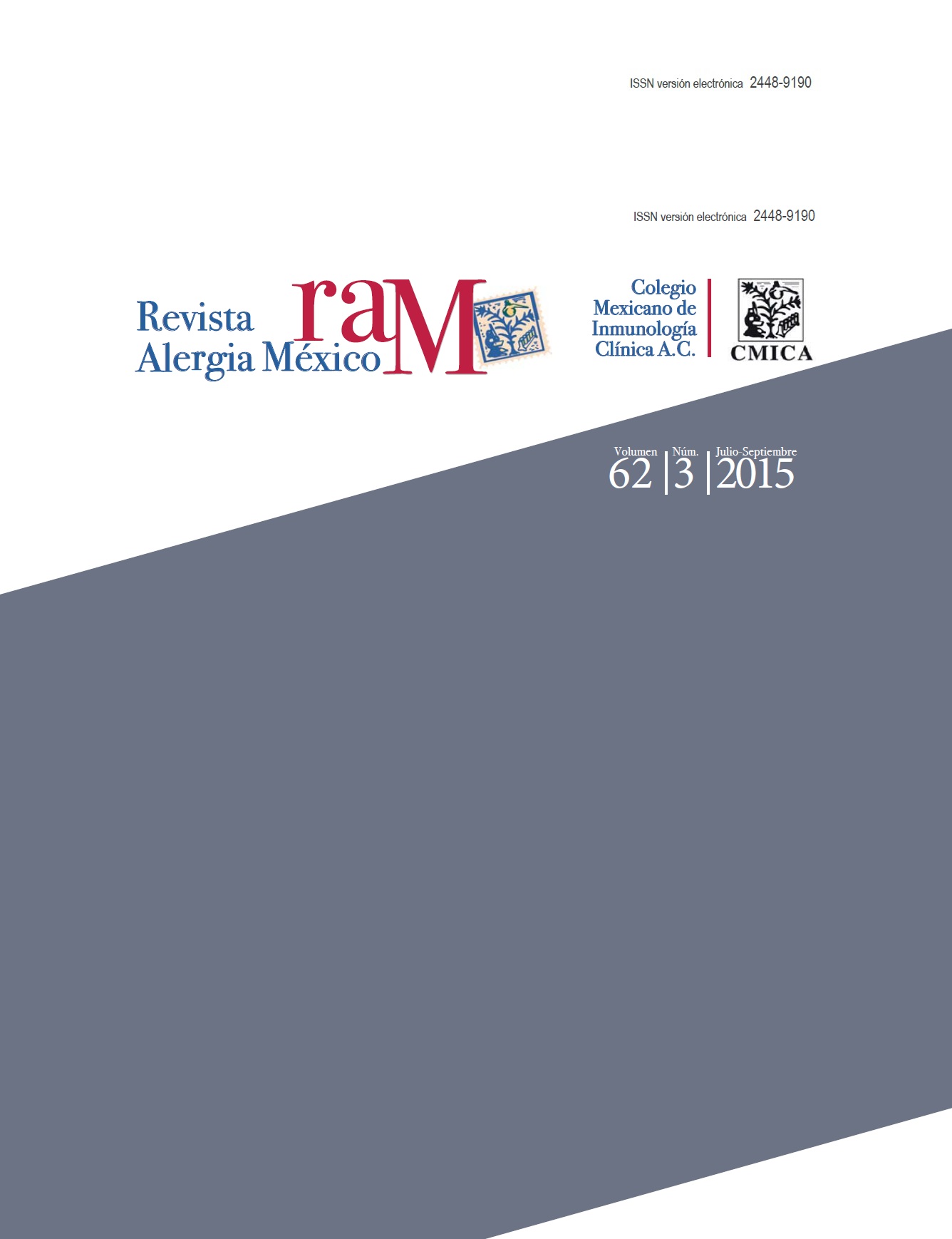Abstract
Background: Although we have epidemiological information on primary immunodeficiencies (PID), the available information is meager in Mexico.
Objective: To provide epidemiological information on the delay in the diagnosis of PID and its correlation to chronic lung damage
Material and method: A retrospective, analytical study was done in patients 0-18 year old age diagnosed with PID for 11 years at the HIMFG (Hospital Infantil de Mexico Federico Gomez). The variables studied were: age at symptom onset, age at diagnosis, time from onset of symptoms to diagnosis, number of previous pneumonias and studies with radiographic chronic lung damage data.
Results: 48 patients were obtained after meeting inclusion criteria; 33 showed lung damage at diagnosis, antibody deficiency being the most affected group. Relating age of onset of symptoms and the time difference of the onset of symptoms to diagnosis showed a strong correlation (p < 0.001, Rho > 0.80). A moderate correlation between the observed time difference vs number of pneumonias (p=0.005, Rho=0.495) and correlation between number of pneumonia and lung damage was highly significant (p <0.001, Rho=0.704).
Conclusion: A strong relationship between the elapsed time from onset of symptoms and the number of pneumonia with lung injury time was found. So, the recurrent pneumonia (> 2) must make suspect the diagnosis of PID, as recommended in the literature.
References
Bonilla, F.A., et al., Practice parameter for the diagnosis and management of primary immunodeficiency. Ann Allergy Asthma Immunol, 2005. 94(5 Suppl 1): p. S1-63.
Casanova, J.L., et al., Revisiting human primary immunodeficiencies. J Intern Med, 2008. 264(2): p. 115-27.
Notarangelo, L.D., Primary immunodeficiencies. J Allergy Clin Immunol, 2010. 125(2 Suppl 2): p. S182-94.
Azarsiz, E., et al., Consanguinity rate and delay in diagnosis in Turkish patients with combined immunodeficiencies: a single-center study. J Clin Immunol, 2011. 31(1): p. 106-11.
Ballow, M., et al., Immunodeficiencies. Clin Exp Immunol, 2009. 158 Suppl 1: p. 14-22.
Barbouche, M.R., et al., Primary immunodeficiencies in highly consanguineous North African populations. Ann N Y Acad Sci, 2011. 1238: p. 42-52.
Sanal, O. and I. Tezcan, Thirty years of primary immunodeficiencies in Turkey. Ann N Y Acad Sci, 2011. 1238: p. 15-23.
Martin-Nalda, A., et al., [Spectrum of primary immunodeficiencies in a tertiary hospital over a period of 10 years]. An Pediatr (Barc), 2011. 74(2): p. 74-83.
Modell, V., et al., Global study of primary immunodeficiency diseases (PI)--diagnosis, treatment, and economic impact: an updated report from the Jeffrey Modell Foundation. Immunol Res, 2011. 51(1): p. 61-70.
Condino-Neto, A., et al., Critical issues and needs in management of primary immunodeficiency diseases in Latin America. Allergol Immunopathol (Madr), 2011. 39(1): p. 45-51.
Etzioni, A. and R. Sorensen, [Early Diagnosis and Adequate Treatment- for Improving and Saving the life of Patients with Primary Immunodeficiencies]. Rev Alerg Mex, 2012. 59(1): p. 1-2.
Condino-Neto, A., et al., Advancing the management of primary immunodeficiency diseases in Latin America: Latin American Society for Immunodeficiencies (LASID) Initiatives. Allergol Immunopathol (Madr), 2012. 40(3): p. 187-93.
Group of Pediatric, I., et al., Comment on: advances in primary immunodeficiency diseases in Latin America: epidemiology, research, and perspectives. Ann. N.Y. Acad. Sci. 1250: 62-72 (2012). Ann N Y Acad Sci, 2013. 1306: p. 71-2.
Leiva, L.E., et al., Primary immunodeficiency diseases in Latin America: proceedings of the Second Latin American Society for Immunodeficiencies (LASID) Advisory Board. Allergol Immunopathol (Madr), 2011. 39(2): p. 106-10.
Leiva, L.E., et al., Primary immunodeficiency diseases in Latin America: the second report of the LAGID registry. J Clin Immunol, 2007. 27(1): p. 101-8.
Zelazko, M., et al., Primary immunodeficiency diseases in Latin America: first report from eight countries participating in the LAGID. Latin American Group for Primary Immunodeficiency Diseases. J Clin Immunol, 1998. 18(2): p. 161-6.
Cunningham-Rundles, C., Lung disease, antibodies and other unresolved issues in immune globulin therapy for antibody deficiency. Clin Exp Immunol, 2009. 157 Suppl 1: p. 12-6.
Cantani, A. and M. Ferrara, The lung and primary immunodeficiency. Allergol Immunopathol (Madr), 1988. 16(6): p. 429-37.
Dukes, R.J., E.C. Rosenow, 3rd, and P.E. Hermans, Pulmonary manifestations of hypogammaglobulinaemia. Thorax, 1978. 33(5): p. 603-7.
Sweinberg, S.K., et al., Retrospective analysis of the incidence of pulmonary disease in hypogammaglobulinemia. J Allergy Clin Immunol, 1991. 88(1): p. 96-104.
Watts, W.J., et al., Respiratory dysfunction in patients with common variable hypogammaglobulinemia. Am Rev Respir Dis, 1986. 134(4): p. 699-703.
Sorensen, R., et al., Collaborating to improve quality of life in primary immunodeficiencies: World PI Week, 2013. J Clin Immunol, 2013. 33(7): p. 1145-8.
Al-Herz, W., et al., Primary immunodeficiency diseases: an update on the classification from the international union of immunological societies expert committee for primary immunodeficiency. Front Immunol, 2011. 2: p. 54.
Jeffrey Modell Foundation (2014) Disponible en: http://www.info4pi.org/library/educational-materials/10-warning-signs
O'Sullivan, M.D. and A.J. Cant, The 10 warning signs: a time for a change? Curr Opin Allergy Clin Immunol, 2012. 12(6): p. 588-94.

This work is licensed under a Creative Commons Attribution-NonCommercial 4.0 International License.
Copyright (c) 2015 Revista Alergia México

